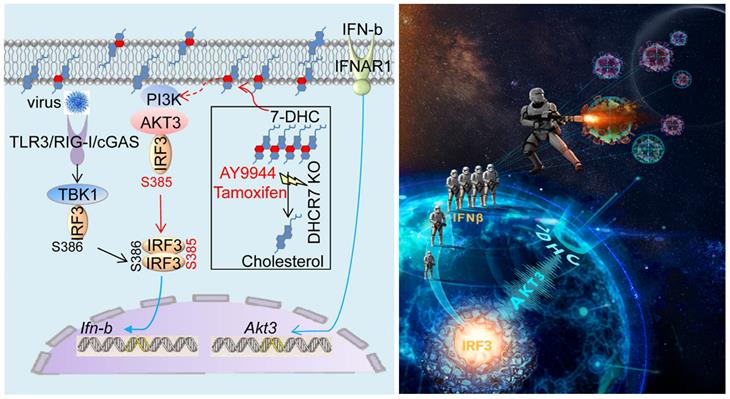Targeting cholesterol metabolism in macrophage to eliminate viral infection
Source:Jun Xiao
2019-12-31
Recent growing interests link cholesterol metabolism to innate immunity. Upon viral infection, macrophages show a reduction in cholesterol synthesis that is accompanied with the enhanced expression of antiviral genes, including type I interferon (IFN-I). Furthermore, IFN-I can induce 25-hydroxycholesterol (25-HC) accumulation, which blocks viral entry. However, the current understandings are limited regarding whether other cholesterol-associated metabolic products or enzymes regulate innate immunity.
In a recently study published in IMMUNITY, Wang Hongyan's team from the Center for Excellence in Molecular and Cellular Science (Institute of Biochemistry and Cell Biology), Chinese Academy of Sciences, in collaboration with Professor Wei Bin at Shanghai University (the former PI in Wuhan Institute of Virology, Chinese Academy of Sciences), have screened expression levels of multiple enzymes that regulate cholesterol metabolism. They found that Dhcr7 levels were significantly decreased in liver tissue from patients infected with Hepatitis B virus or from mice infected with vesicular stomatitis virus (VSV). DHCR7 is 7-dehydrocholesterol reductase, which converts 7-dehydrocholesterol (7-DHC) into cholesterol. Patients carrying Dhcr7 mutations have mental retardation. However, the role of DHCR7 in innate immunity is unknown.
This study has elucidated that DHCR7 knock-out (KO) or the DHCR7 inhibitor treatment can promote IRF3 activation and type I interferon (IFNβ) production to clear multiple viruses in vitro or in vivo.
Interestingly, Tamoxifen, a chemotherapy drug used to treat breast cancer, was approved by FDA to inhibit DHCR7’s enzyme activity. This study found that Tamoxifen treatment inhibits vesicular stomatitis virus (VSV) and Zika virus (ZIKV) infection at cellar levels, suggesting a possible application of Tamoxifen for anti-infections.
Interestingly, mice treated with the DHCR7 inhibitor AY9944 showed a significant increase in 7-DHC content in serum. Treatment with the natural product 7-dehydrocholesterol (7-DHC) can promote IRF3 phosphorylation and enhance IFNβ production in macrophages.
They further elucidated that viral infection enhanced AKT3 expression and 7-DHC treatment further activated AKT3. AKT3 directly bound and phosphorylated IRF3 at Ser385, together with TBK1-induced phosphorylation of IRF3 Ser386, to achieve IRF3 dimerization and full activation.
In conclusion, this study reveals that both cholesterol intermediate metabolite 7-DHC and the DHCR7 inhibitors promote IFN-I production and antiviral response by activating AKT3 and IRF3. This study might be helpful for developing new drugs against viral infections, which also provides new insights to understand how cholesterol metabolism regulates innate immunity.
Thanks to Zhai Qiwei (PI, Shanghai Institute of Nutrition and Health, Chinese Academy of Sciences), Chen Hualan (PI, Harbin Veterinary Research Institute, Chinese Academy of Agricultural Sciences) and Yang Zhongzhou (PI, Model Animal Research Institute, Nanjing University). This work was supported by grants from Chinese Academy of Sciences, the Ministry of Science and Technology of China, and National Natural Science Foundation of China.

Links: https://www.cell.com/immunity/fulltext/S1074-7613(19)30496-0
In a recently study published in IMMUNITY, Wang Hongyan's team from the Center for Excellence in Molecular and Cellular Science (Institute of Biochemistry and Cell Biology), Chinese Academy of Sciences, in collaboration with Professor Wei Bin at Shanghai University (the former PI in Wuhan Institute of Virology, Chinese Academy of Sciences), have screened expression levels of multiple enzymes that regulate cholesterol metabolism. They found that Dhcr7 levels were significantly decreased in liver tissue from patients infected with Hepatitis B virus or from mice infected with vesicular stomatitis virus (VSV). DHCR7 is 7-dehydrocholesterol reductase, which converts 7-dehydrocholesterol (7-DHC) into cholesterol. Patients carrying Dhcr7 mutations have mental retardation. However, the role of DHCR7 in innate immunity is unknown.
This study has elucidated that DHCR7 knock-out (KO) or the DHCR7 inhibitor treatment can promote IRF3 activation and type I interferon (IFNβ) production to clear multiple viruses in vitro or in vivo.
Interestingly, Tamoxifen, a chemotherapy drug used to treat breast cancer, was approved by FDA to inhibit DHCR7’s enzyme activity. This study found that Tamoxifen treatment inhibits vesicular stomatitis virus (VSV) and Zika virus (ZIKV) infection at cellar levels, suggesting a possible application of Tamoxifen for anti-infections.
Interestingly, mice treated with the DHCR7 inhibitor AY9944 showed a significant increase in 7-DHC content in serum. Treatment with the natural product 7-dehydrocholesterol (7-DHC) can promote IRF3 phosphorylation and enhance IFNβ production in macrophages.
They further elucidated that viral infection enhanced AKT3 expression and 7-DHC treatment further activated AKT3. AKT3 directly bound and phosphorylated IRF3 at Ser385, together with TBK1-induced phosphorylation of IRF3 Ser386, to achieve IRF3 dimerization and full activation.
In conclusion, this study reveals that both cholesterol intermediate metabolite 7-DHC and the DHCR7 inhibitors promote IFN-I production and antiviral response by activating AKT3 and IRF3. This study might be helpful for developing new drugs against viral infections, which also provides new insights to understand how cholesterol metabolism regulates innate immunity.
Thanks to Zhai Qiwei (PI, Shanghai Institute of Nutrition and Health, Chinese Academy of Sciences), Chen Hualan (PI, Harbin Veterinary Research Institute, Chinese Academy of Agricultural Sciences) and Yang Zhongzhou (PI, Model Animal Research Institute, Nanjing University). This work was supported by grants from Chinese Academy of Sciences, the Ministry of Science and Technology of China, and National Natural Science Foundation of China.

Left: the research model; Right: cartoon of this work. When the Alien (virus) invades the Earth (host cell), the Early Warning System (7DHC) transmits the signal (AKT3) to the center of the Earth (IRF3) , dispatches the troops (IFNβ) to fight against the alien invasion.
Links: https://www.cell.com/immunity/fulltext/S1074-7613(19)30496-0


